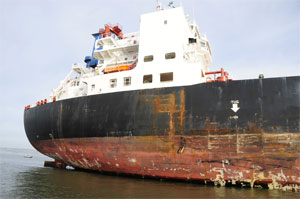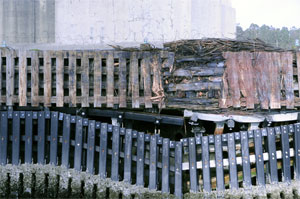Changes in best practices for vessels in San Francisco Bay have been proposed after an oil tanker struck a bridge tower.
The bar pilot who was guiding Overseas Reymar has been placed on administrative leave after the 752-foot vessel ran into a tower of the San Francisco-Oakland Bay Bridge on Jan. 7, damaging the fender system. Unbeknownst to the pilot, a radar beacon that guides ships through the bridge span was not functioning.
 |
|
Overseas Reymar was damaged on its starboard quarter. |
The accident happened at about 1120. The outbound vessel’s speed was about 11 knots with a 3-knot following current, said Capt. Peter McIsaac, president of the San Francisco Bar Pilots. Initially, visibility was a half-mile.
“But the fog changed throughout the transit,” said Petty Officer Michael Lutz, a spokesman at Coast Guard Sector San Francisco.
The pilot changed course before transiting the bridge. In his check in with Vessel Traffic Service (VTS) San Francisco, the pilot reported Overseas Reymar would go between towers C and D, according to McIsaac. But as the tanker approached the bridge, he changed course to go through the span between towers D and E. The ship struck tower E.
Two spans in the bridge are 2,200 feet wide: between A and B and between D and E. Two spans in the bridge are 1,070 feet wide: between towers B and C and between C and D.
VTS cautioned the pilot, said Capt. Cynthia Stowe, commanding officer of Coast Guard Sector San Francisco.
“VTS did talk to him in advance of the allision and they warned him about his position,” Stowe said. However, “there is not a lot of time when you are in that point of the transit.”
The radar beacon for the span between towers C and D, marking the middle of the span, was broken on Jan. 7. This was not discovered until the day after the incident, according to McIsaac. Having that beacon out “does make it a little disconcerting when you are setting up for it and you realize you’re not getting any response from the racon,” he said.
There were no injuries or pollution. There was no damage to the bridge’s structure or foundation. The tanker, which was in ballast, was damaged on the starboard quarter.
Drug and alcohol tests of the pilot, master and key crewmembers were negative, according to the Coast Guard. The pilot has been placed on administrative leave, McIsaac said.
The Coast Guard is coordinating the investigation with the National Transportation Safety Board (NTSB). That agency was brought in because the accident exceeded $500,000 in damage, thus making it a major marine casualty.
Immediately after the incident, Stowe asked the Harbor Safety Committee (HSC) of the San Francisco Bay Region to review guidelines for vessel traffic, especially at the Bay Bridge.
This is the second time in five years that the bridge has been hit. On Nov. 7, 2007, the 901-foot containership Cosco Busan struck the D tower of the Bay Bridge, spilling about 53,000 gallons of heavy fuel oil. Cosco Busan was sailing in heavy fog at the time.
As a result of the Cosco Busan casualty, the harbor committee was directed to come up with best maritime practices to improve transit in the harbor. The guidelines include speed restrictions and recommendations on navigation in reduced visibility or severe weather.
In addition, the HSC created nine Critical Maneuvering Areas (CMA), where additional standards of care are needed due to a narrow channel, adverse currents or nearby hazards. The Bay Bridge is not a CMA.
The HSC’s navigation work group is considering several new recommendations. One is to designate specific spans for transiting at the Bay Bridge. If there is reduced visibility, vessels should go through the wider spans, according to Capt. Lynn Korwatch, HSC chair and director of the Marine Exchange of the San Francisco Bay Region.
The other recommendation is to create a CMA at the Bay Bridge. This would mean that outbound traffic should not transit in reduced visibility or fog. Currently, large vessels and tugs with tows over 1,600 gt should not transit through a CMA or leave the dock when visibility is less than half a nautical mile.
The proposed CMA would not apply to inbound traffic. Limiting the traffic inbound “could end up causing more problems,” said Korwatch. “Then (vessels) are doing circles in the central bay.”
A third idea is to ask pilots to report weather conditions more frequently to VTS. Pilots report conditions as they leave the dock.
“They are not required to report on what their visibility may be anywhere in the transit,” said Korwatch. “We’re asking pilots and the community to be more proactive at reporting weather conditions throughout the day so that vessel traffic has a better sense of what conditions are,” she said.
McIsaac has concerns about additional reporting of conditions to VTS. “I told the Coast Guard, that as far as I’m concerned, the pilot and the captain’s heads need to be in the radar at these times,” he said.
The list of best practices for the bay is a voluntary system, according to Stowe, created with the help of various stakeholders in the bay. The HSC can approve new recommendations through public meetings, but it does not need to go through a lengthy rulemaking process. “Once they’re voted on and approved by the committee, they will be implemented immediately,” she said of the proposed new recommendations.
The bridge fenders on tower E were damaged. It will take about four and a half months to fix them. The state has budgeted $3 million, said Robert Haus, spokesman for the California Department of Transportation.

